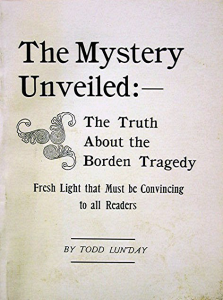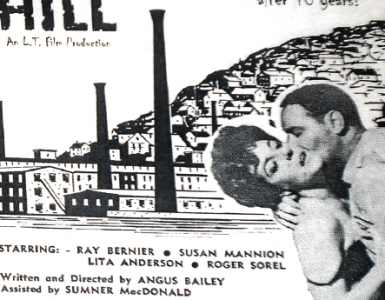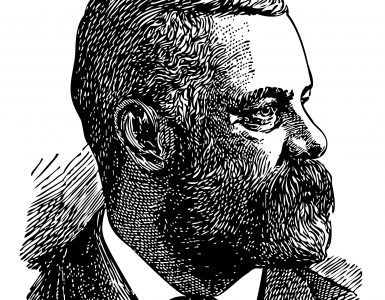by Eugene Hosey
First published in November/December, 2008, Volume 5, Issue 4, The Hatchet: Journal of Lizzie Borden Studies.
 The Mystery Unveiled: Truth About the Borden Tragedy is a unique and provocative thesis that satirizes Lizzie Borden’s acquittal and examines the logistical and psychological challenges of a mystery killer. The author’s theoretical villain tries in vain to recreate the crime scene of August 4 at the Borden house. Written in 1893, soon after and with obvious knowledge and understanding of the trial, the text fairly drips with sarcastic irony, as simple logic overwhelms the mysterious stranger/intruder theory. Simultaneously, the author obliquely makes a case for Lizzie’s guilt—while literally affirming the innocence of the one who was acquitted, or “the Party of unhindered opportunity.” The essay’s premise is that there are two suspects—the one who was declared not guilty by the justice system, and the one who is an utter mystery to everybody:
The Mystery Unveiled: Truth About the Borden Tragedy is a unique and provocative thesis that satirizes Lizzie Borden’s acquittal and examines the logistical and psychological challenges of a mystery killer. The author’s theoretical villain tries in vain to recreate the crime scene of August 4 at the Borden house. Written in 1893, soon after and with obvious knowledge and understanding of the trial, the text fairly drips with sarcastic irony, as simple logic overwhelms the mysterious stranger/intruder theory. Simultaneously, the author obliquely makes a case for Lizzie’s guilt—while literally affirming the innocence of the one who was acquitted, or “the Party of unhindered opportunity.” The essay’s premise is that there are two suspects—the one who was declared not guilty by the justice system, and the one who is an utter mystery to everybody:
Only one person had unhindered opportunity to commit the deed. It is certain that the wrong was done by this person or some unknown party. We have, therefore, with positive certainty limited our search for the felon to these two, and inasmuch as one of these, the first party, has been indicted for the crime and formally tried before a properly impaneled jury, according to the statutes of Massachusetts, and acquitted, the case is narrowed down to one—the unknown party. The person of unhindered opportunity is therefore ex cathedra, not within the range of present inquiries, and is hereby dropped as a possible consideration. The writer is profoundly a respecter of law, and has always tried to be law-abiding, and he has not the slightest disposition to disparage the legal proceedings as they bear upon the case, and he desires to have that fact definitely understood by the reader at the onset.
Bitter disappointment in the Borden verdict seems to be a primary impulse behind the analysis. In a sense, the essay is a protest. By feigning acceptance of Lizzie’s innocence in the text, and disproving the mysterious stranger theory according to the narrow parameters of his definitions, the author concludes his analysis by taking his satire to its ultimately sardonic conclusion:
. . . AND I HAVE DEMONSTRATED IN THE PAGES OF THIS VOLUME THE ABSOLUTE AND ENTIRE INNOCENCE OF THE SECOND PARTY, LEAVING NO GROUNDS FOR ANY DOUBT. IT, THEREFORE, FOLLOWS THAT NO MURDER WAS COMMITTED. O LAND OF THE FREE IN WHICH THE FOULEST OF CRIMES MAY BE COMMITTED IN THE QUIET OF THE HOME, EVEN IN THE OPEN BLAZE OF MIDDAY, AND YET NOBODY THE DOER!
The mysterious killer of The Mystery Unveiled, “Villain” as named by the author, is a total outsider without any connection to anyone in the Borden family, an intruder motivated by senseless bloodlust. The author’s goal, as he explains it, is to prove, through a scrutiny of the logistical realities of the Borden house on the morning of the murders, that this suspect could not be the killer—in fact, could not have even conceived to undertake such a crime.
The author is writing at a time when the Borden murders and the verdict are much-discussed and controversial. He has undertaken this small volume, he says, in order to clarify a case that exists in a condition of much confusion, and to put to rest society’s fear that the Borden axe murderer might strike again.
The author uses a process of deduction to demonstrate, through detailed considerations, how it was impossible for Villain to have committed the crimes. He writes at length about the extreme unlikelihood of an outsider even getting into the Borden house undetected, pointing out that even if the killer watched the house and saw Morse and Mr. Borden leave—and even if he happened to wait until Bridget left the house for window-washing—there would still be two people inside to duck and hide from, as the killer made his way up to the guest room. And assuming Lizzie’s complete innocence in the whole tragedy, how could a killer possibly escape Lizzie’s notice as she moved from one room to the next? And how could Villain know that Abby was in the guest room—if he were actually seeking her as his first victim—and manage to enter the room and kill her without an outcry from the old woman? The author is convinced that Villain would have to have taken Abby unawares and, therefore, would have had to have gotten to the guest room before Abby—which would have been practically impossible.
The writer then paints a picture of the difficulty, the nerve-racking risk on the part of the killer, and the unrealistic layout of the household, as Villain hides in the guest room for an hour and a half between the two murders. There is at this juncture a serious error in the analysis—a baseless presumption, in fact—that the guest room door must have been open the whole time. Perhaps the author gets his conviction that this door was open the whole time because Mrs. Churchill and Bridget Sullivan discovered it this way when they went up the stairs and found Mrs. Borden. In fact, this door certainly could have been closed during the time between the two murders.
A cogent argument is made about the thought process and the decision-making of Villain as the time for the second murder approaches. How does he know when the coast is clear downstairs—that Bridget is up in her room, Lizzie has stepped out, and Mr. Borden is napping in the sitting room? This, of course, would not seem possible. The real answer to the question is that the murder did not happen this way. So, does The Mystery Unveiled successfully demonstrate that Lizzie Borden is guilty and that no mystery person could have committed the crimes? It cleverly works to the extent that it shows the extreme unlikelihood that Lizzie is actually an innocent bystander. It succeeds equally in showing the extreme unlikelihood that the killer is a mystery person who is also a true stranger to everyone in the family.
But this essay is no solution to the Borden tragedy. Its major flaw in terms of getting at the truth is the presumption that Villain has no connection or knowledge of the Bordens—in particular, of Lizzie. The essay does not delve deeply enough into the mystery to prove the guilt of anyone—except for the probable guilt by association of Lizzie, and this to an uncertain degree. There is plenty of evidence indicating Lizzie Borden is not innocent. But it is a whole other difficulty beyond that to show, by evidence or circumstances, that Lizzie is an axe murderer. In fact, the “mystery person” category of theory is broad—much broader than this author seems to have imagined. There is the mystery person who knows at least one member of the family—the mystery person with a mystery motive.
It must be pointed out that this work includes some errors, in addition to the unwise assumption about the guest room door. There are at least two that would seem to be very detrimental to the theory—that no one was seen loitering in front of the house murder morning, for example. In fact, there was at least one such person, possibly described by more than one witness. The author also does not seem to realize that according to Bridget’s testimony, the screen door was left unlatched during the outside window-washing, and was unobserved for a fairly long period of time.
The Mystery Unveiled is a remarkable work on a small scale and should be read by Borden enthusiasts. One of the first essays about the crimes, written at a time when the trial was fresh in the minds of the public, it conveys something of the unease and frustration that must have been commonplace. And it is a work of clever satire within its limits. It is a valuable read worth an occasional re-read. The author’s probing rationale stimulates the consideration of many possibilities and alternatives that exist in the mind of everyone who has tried to solve the case.






